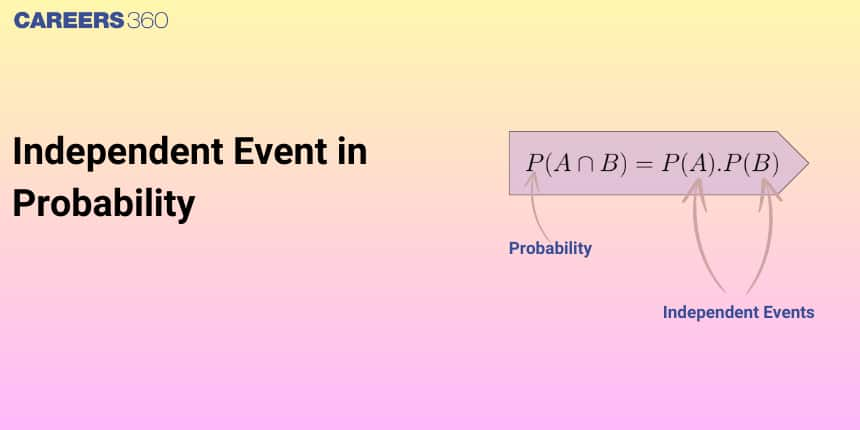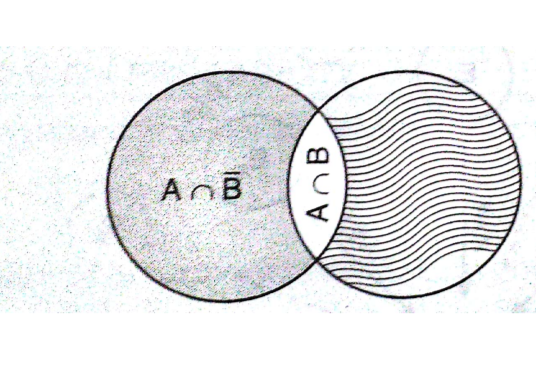Independent Event in Probability
Probability is defined as the ratio of the number of favourable outcomes to the total number of outcomes. In probability, an independent event is an important concept. Independent events are those events whose presence doesn't affect others. These operations on the events show us how the values are related. it is important in theoretical mathematics. It is also used in various fields like statistics, finance, etc.
JEE Main: Study Materials | High Scoring Topics | Preparation Guide
JEE Main: Syllabus | Sample Papers | Mock Tests | PYQs

Events
The set of outcomes from an experiment is known as an Event.
When a die is thrown, sample space
Let
Here,
Also, observe that
Now, what is the occurrence of an event?
From the above example, the experiment of throwing a die. Let
Thus, the event
Independent Events
Two or more events are said to be independent if the occurrence or non-occurrence of any of them does not affect the probability of occurrence or non-occurrence of other events.
If

Two events
A third result can also be obtained for independent events
From the multiplication rule of probability, we have
Now if
To show two events are independent, you must show only one of the above three conditions.
If two events are NOT independent, then we say that they are dependent.
With and Without replacement
In some questions, like the ones related to picking some object from a bag with different kinds of objects in it, objects may be picked with replacement or without replacement.
With replacement: If each object is re-placed in the box after it is picked, then that object has the possibility of being chosen more than once. When sampling is done with replacement, then events are considered to be independent, meaning the result of the first pick will not change the probabilities for the second pick.
Without replacement: When sampling is done without replacement, the probabilities for the second pick are affected by the result of the first pick. The events are considered to be dependent or not independent.
Difference between Independent events and Mutually Exclusive events
But in the case of independent events
Three Independent Events
Three events
If at least one of the above is not true for three given events, we say that the events are not independent.
Properties of Independent Event
If
1.
2. Event
3. Event
4. Event
these concepts can help in solving gaining deeper insights and contributing meaningfully to real-life problems.
Solved Examples Based on Independent Events
Example 1: Let two fair six-faced dice
1)
2)
3)
4)
Solution
Independent events -
Therefore,
Hence, the answer is the option 4.
Example 2:Four persons can hit a target correctly with probabilities
2)
3)
4)
Solution
The desired Probability is
Hence, the answer is the option (4).
Example 3: Let
where
1) independent but not equally likely.
2) independent and equally likely.
3) mutually exclusive and independent.
4) equally likely but not independent.
Solution
Addition Theorem of Probability -
In general:
Also,
Example 4: Let A, B and C be three events, which are pair-wise independent and
2)
3)
4)
Solution
Addition Theorem of Probability -

Example 5: For any two events
does not hold.
2)
3)
Solution
Independent events -
and
Hence, the answer is an option 3.
Frequently Asked Questions (FAQs)
Probability is defined as the ratio of the number of favorable outcomes to the total number of outcomes
The set of outcomes from an experiment is known as an Event.
Two or more events are said to be independent if the occurrence or non-occurrence of any of them does not affect the probability of occurrence or non-occurrence of other events.
Also Read
13 Feb'25 07:43 PM
12 Feb'25 01:49 AM
12 Feb'25 01:46 AM
12 Feb'25 01:45 AM
12 Feb'25 01:44 AM
12 Feb'25 01:41 AM
12 Feb'25 01:40 AM
15 Oct'24 01:40 PM
15 Oct'24 01:36 PM

